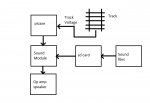I've had an idea for creating a non dcc sound modual for a model railway that could be built for under £20
While watching a youtube video of various locos doing their thing, I thought it would be interesting to take some sound clips of the locos and play them in relation to the track voltage on a small shunting plank that I'm in the process of making.
http://www.rmweb.co.uk/community/index.php?/topic/64767-an-asymetrical-double-outside-slip-mk2/
There would only need to be a small number of sound files that would be called upon in relation to the track voltage
eg: 0-1v engine idle
2-5v engine accelerate
5v+ full power
a decrease in voltage from a higher voltage= engine decelerating.
I searched the forum archives and came up with this interesting thread, which having read through it a few times, I think is within my ability
http://www.picaxeforum.co.uk/showthread.php?16353-mp3-playback-module
I then put together a block diagram which I think covers all the bases

However the one thing I need some advice on, is how to convert the track voltage, which can be anywhere between 0v-14v at 1-2amps into something the picaxe can handle. I've used the readc command successfully before, however I do know that I can't put 12vdc in to one of the axes input pins.
Please could someone advise
Rgds,
Sid
While watching a youtube video of various locos doing their thing, I thought it would be interesting to take some sound clips of the locos and play them in relation to the track voltage on a small shunting plank that I'm in the process of making.
http://www.rmweb.co.uk/community/index.php?/topic/64767-an-asymetrical-double-outside-slip-mk2/
There would only need to be a small number of sound files that would be called upon in relation to the track voltage
eg: 0-1v engine idle
2-5v engine accelerate
5v+ full power
a decrease in voltage from a higher voltage= engine decelerating.
I searched the forum archives and came up with this interesting thread, which having read through it a few times, I think is within my ability
http://www.picaxeforum.co.uk/showthread.php?16353-mp3-playback-module
I then put together a block diagram which I think covers all the bases

However the one thing I need some advice on, is how to convert the track voltage, which can be anywhere between 0v-14v at 1-2amps into something the picaxe can handle. I've used the readc command successfully before, however I do know that I can't put 12vdc in to one of the axes input pins.
Please could someone advise
Rgds,
Sid

